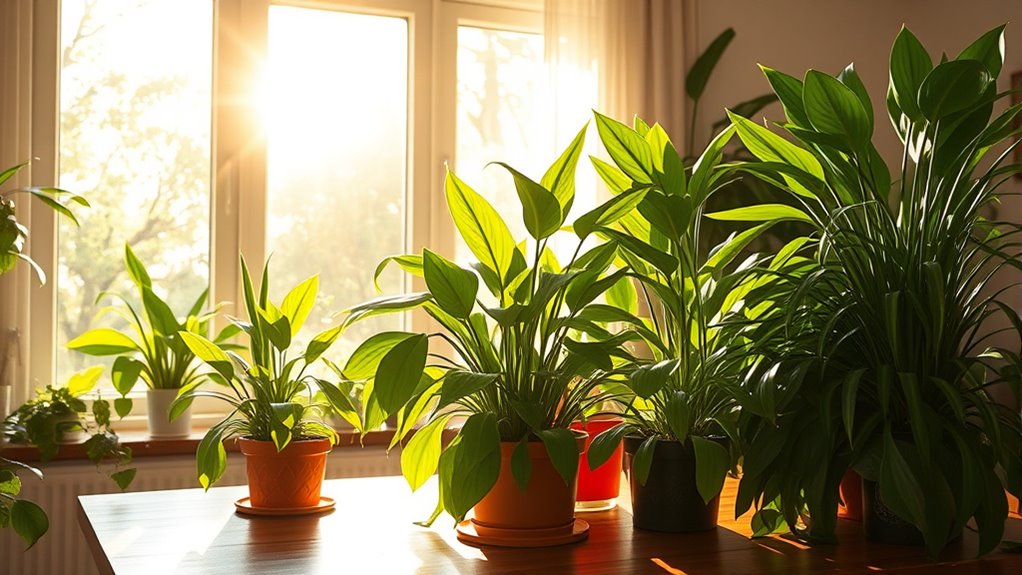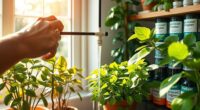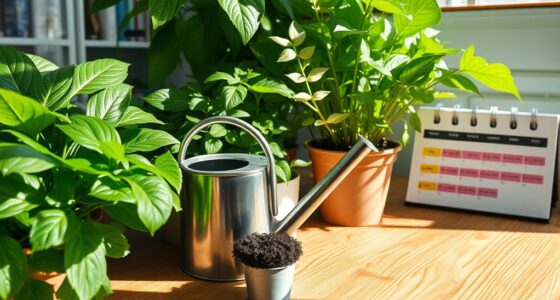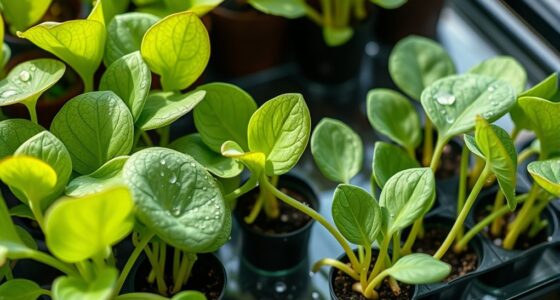Longer days in summer mean your indoor plants get more sunlight, which boosts their growth. Increased light energizes photosynthesis, helping them develop larger leaves, stronger stems, and more flowering buds. You’ll notice growth spurt patterns happening faster during this time. To optimize results, adjust your watering and positioning to match these seasonal changes. Want to keep your plants thriving all summer long? Keep exploring for more tips on maximizing their growth potential.
Key Takeaways
- Longer daylight hours enhance photosynthesis, promoting larger leaves, stronger stems, and more flowering buds indoors.
- Increased sunlight accelerates soil drying, requiring more frequent watering to support rapid plant growth.
- Positioning plants near south-facing windows or using grow lights maximizes light exposure for optimal development.
- Proper watering based on soil moisture prevents root rot while providing energy for summer growth spurts.
- Seasonal changes in light and moisture levels create ideal conditions for indoor plants to thrive during longer summer days.

Have you ever wondered why kids seem to grow so much faster during summer? It’s because of the longer days and increased sunlight exposure, which aren’t just good for children’s growth—they also influence how your indoor plants thrive. When the days get longer, your plants receive more hours of sunlight, which is essential for photosynthesis. This process fuels their growth, encouraging bigger, healthier leaves, stronger stems, and even new flowering buds. As daylight extends, plants absorb more light energy, boosting their overall vitality. But remember, sunlight isn’t the only factor at play; how often you water your plants during this time also becomes essential.
During summer, the natural increase in sunlight exposure tends to dry out the soil faster. If you stick to your usual watering schedule without adjusting for the season, your plants might end up with underwatering issues, which can stunt growth or cause leaves to wilt. To support their summer growth spurts, you should consider increasing the watering frequency slightly—without overdoing it. Check the top inch of soil daily; if it feels dry, give your plants a thorough drink. This helps maintain consistent moisture levels, ensuring they have the resources they need to convert sunlight into energy effectively. Overwatering, however, can lead to root rot, so it’s essential to find that sweet spot.
Balancing watering frequency with sunlight exposure is key during the summer months. As your indoor plants get more light, they become more active in their growth, but they also require more water to sustain that energy. Keep a close eye on the soil’s moisture levels and adjust your watering routine accordingly. It’s also helpful to place your plants where they can get ample sunlight, ideally near a south-facing window or under grow lights if natural light is limited. Proper sunlight exposure not only encourages growth but also influences the plant’s overall health, making them more resilient to pests and diseases.
In short, summer’s longer days and increased sunlight exposure naturally stimulate your indoor plants to grow faster. To maximize this growth, adapt your watering frequency to match the season’s demands, ensuring your plants stay healthy and vibrant. By paying attention to both sunlight and soil moisture, you’ll create the ideal environment for your plants to flourish during their summer growth spurts.
Additionally, understanding how growth patterns are affected by environmental factors can help you optimize your plant care routine for the best results.
Frequently Asked Questions
Do All Indoor Plants Respond the Same Way to Longer Daylight Hours?
Not all indoor plants respond the same way to longer daylight hours because of species variation. Some plants, like succulents, may slow their growth rate, while others, such as leafy greens, thrive and grow faster. Your plants’ reactions depend on their specific light needs and natural growth cycles. Pay attention to each plant’s signals, and adjust watering and care routines to support healthy growth during longer daylight periods.
How Can I Tell if My Plant Is Overexposed to Summer Light?
You can tell if your plant is overexposed to summer light by watching for leaf scorch, which appears as browning or crisp edges, and color fading, where leaves lose vibrancy. If these signs show up, it means your plant’s getting too much direct sunlight. Move it to a shaded spot or reduce exposure time to help it recover. Regularly check your plant’s leaves to catch overexposure early.
Are Artificial Grow Lights Effective During Summer Growth Spurts?
Artificial grow lights are quite effective during summer growth spurts if you focus on grow light efficiency and light spectrum optimization. You should choose lights that emit the right spectrum for your plant’s growth stage, ensuring maximum energy use. Adjust the height and duration of light exposure to mimic natural sunlight, helping your plants thrive indoors. Properly optimized grow lights can boost growth without risking overexposure or stress.
What Signs Indicate My Plant Needs Less Sunlight in Summer?
You notice your plant’s leaf color changes or wilting signs, which often indicate it needs less sunlight. Coincidentally, during summer, intense sunlight can cause stress, making leaves yellow or pale. If you see these signs, it’s time to move your plant to a shadier spot or reduce outdoor exposure. Less sunlight helps your plant recover, preventing further stress and keeping it healthy and vibrant.
How Does Temperature Interact With Longer Days to Affect Growth?
You might notice that longer days combined with higher temperatures can boost your plant’s growth, but it also risks overheating. Temperature interacts with photosynthesis efficiency, which peaks within specific ranges. If temperatures rise too high, it hampers photosynthesis and stresses your plant. Good temperature regulation helps maintain ideal photosynthesis efficiency, ensuring your indoor plants thrive during longer summer days without suffering from heat stress.
Conclusion
As summer’s long days stretch on, your indoor plants awaken like a city waking at dawn, enthusiastic to grow and thrive. Embrace these seasonal changes, knowing they’re guiding your green friends toward vibrant, lush life—much like a painter’s brushstroke bringing a blank canvas to vivid existence. By understanding this natural rhythm, you nurture not just plants, but a living masterpiece that blooms brighter with each passing day.










